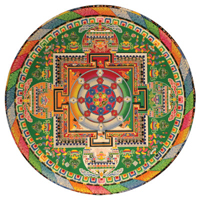
Introduction |
Geography |
History |
Communication |
Beliefs |
Society |
Economy |
Government |
Technology |
Links to Other Websites |
 |
 |
 |
|---|---|---|
Art
“Blue’s Clues”
There are two ways to think about India’s art or even art in general. As you become a good detective, you will begin to recognize these ways.
- Art for the sake of art: using painting and sculpture to express ideas and concepts.
- Art for a practical purpose.
In the second case, this kind of art is that which is used by the people. We often don’t think of this second kind as “artwork” but it is the art of the people. Here is an example of these two kinds of art.
 |
 |
These pictures below show work that is very skillful and many people think they are also beautiful. Yet they were made for a special reason and when they fulfilled that purpose, they were destroyed. They will NOT be put in a museum yet we would call them art.
The first picture is Tibetan Butter Art; all of the sculptures are made of butter and they are used in a special ritual by people who practice Buddhism in Tibet. The second picture is made of sand. It took many days of very patient work for these monks to carefully make this mandala. When the celebration is over for which it was made, the monks will brush the sand picture all together and the mandala will be no more. These are examples of a type of art that is called “ephemeral art” meaning it doesn’t last.


Much of the art in India is based on the religious beliefs of Hinduism and Buddhism. When you know the clues that are given in the artwork, you can know the message the artist was trying to give in the painting.
The biggest figure is usually in the center of the painting. This is the main subject of the artwork.
On either side of the main figure there are often other important characters who are connected to the main figure.
The top of the painting often shows figures who are the teachers of the main figure or they show earlier incarnations. The bottom usually shows figures who are protecting the central figure.
Often the person who commissioned the painting will have some symbols that tell everyone that he paid for this work of art. Sometimes there is an inscription at the very bottom that tells who that patron was or when it was made. In religious art, the artist never signed his name.
Here are several pictures that show this information.
 |
 |
 |
I would like to thank Dina Bangdel for the information she so generously shared at the 2008 NEH Summer Institute and for the use of several of her slides.